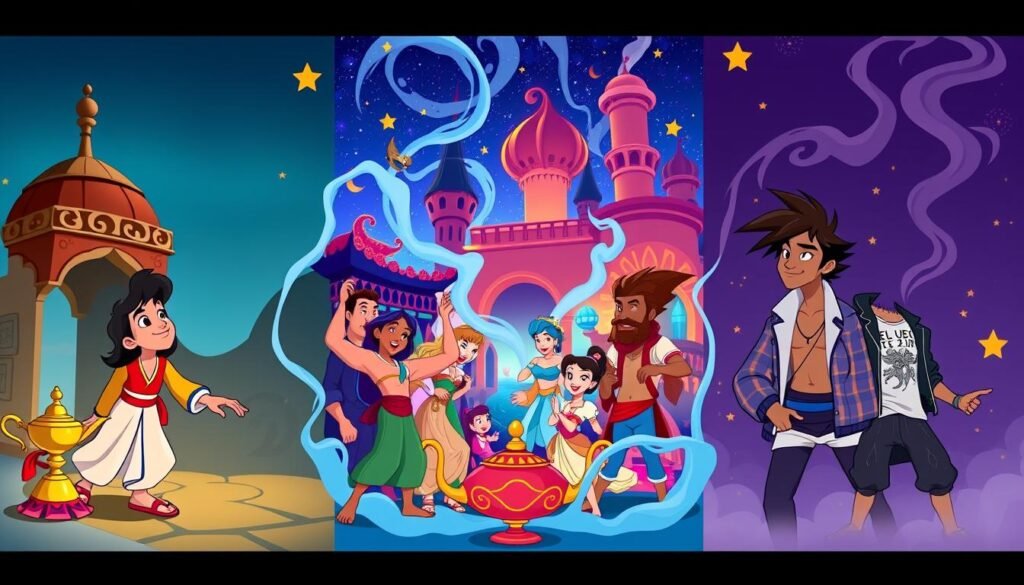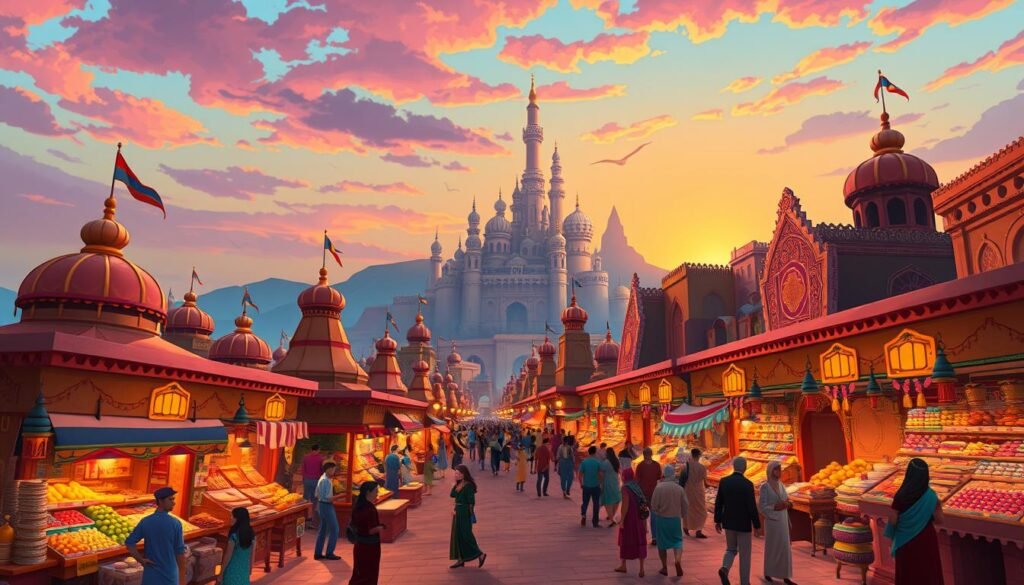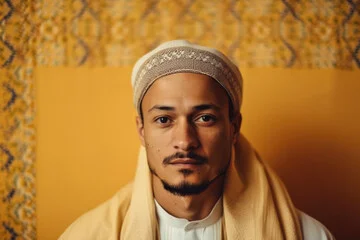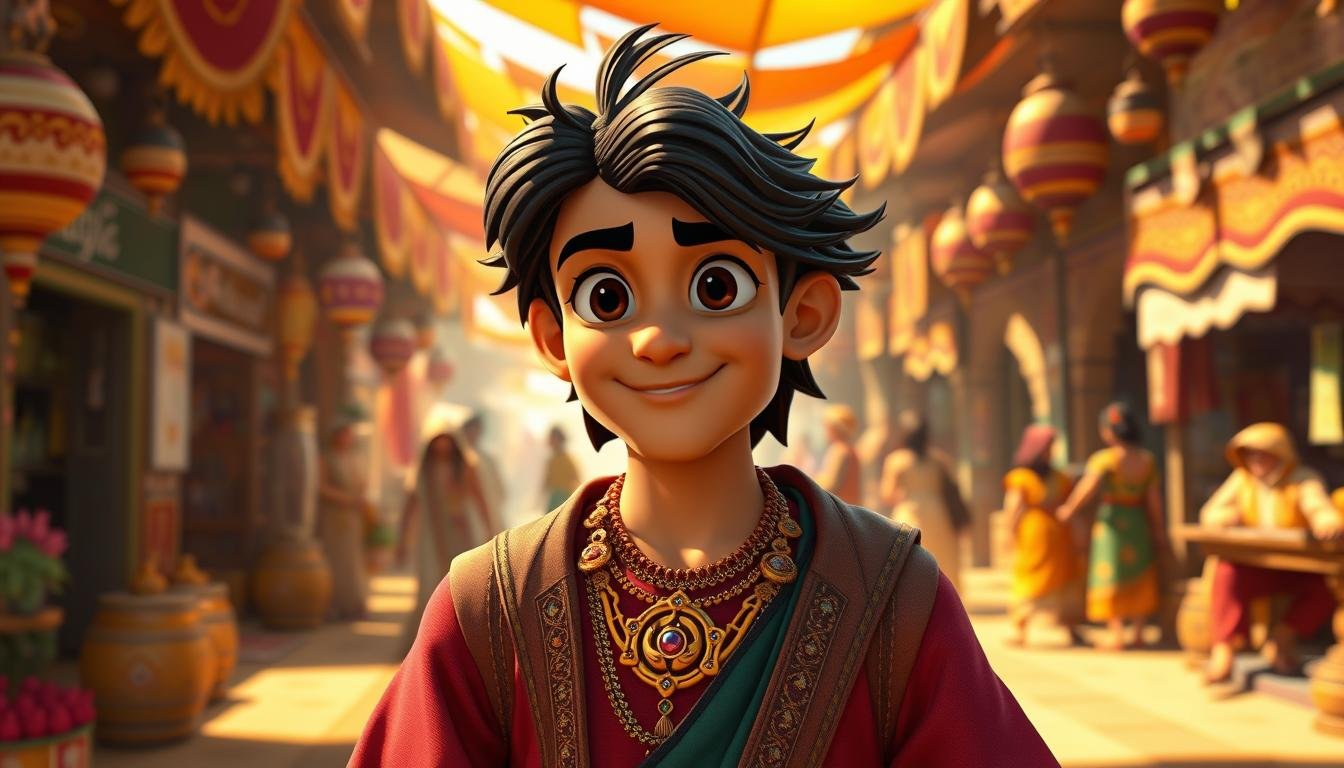Have you ever wondered about Aladdin’s religious identity? As we explore his world, we ask: is Aladdin Muslim? Or is he a figure wrapped in cultural myths? Knowing Aladdin’s cultural roots helps us understand his journey.
From Middle Eastern tales to modern adaptations, Aladdin’s story is rich. By looking at the Islamic themes in his story, we see his cultural identity. This identity connects with both Muslim and non-Muslim fans.
Origins of the Aladdin Folktale
The Aladdin origins are complex and often mixed up by cultural changes over time. The story “Aladdin and the Wonderful Lamp” was first shared by French translator Antoine Galland in the 1700s. It didn’t come from the original One Thousand and One Nights, a key piece of Arabic literature.
Galland learned it from a Syrian storyteller, Hanna Diyab, while traveling. This shows how stories can change as they move from one place to another.
At first, Aladdin’s story was set in China. He was seen as a poor boy facing many challenges. But as the story was retold, it moved to a more familiar Middle Eastern setting. This change shows how stories adapt to fit what people want to see.
Galland’s translation made Aladdin a symbol of a mixed-up story. Elements from different cultures blended together, making the story more complex. Even though it’s known as part of One Thousand and One Nights, Aladdin’s Chinese roots are still important to understand his story.
Historical Context of Aladdin’s Story
The story of Aladdin has a rich history. It first came to Europe in 1704 through a French translation by Antoine Galland. This was part of a collection that included ‘Ali Baba and the Forty Thieves’. This introduction helped shape how we see Aladdin today.
The original Aladdin story is set in China, with Chinese characters. The bad guy comes from North Africa. This mix shows how people from the East were seen as exotic and mysterious back then.
The Disney version changed things a lot. It made Agrabah a place of mystery and magic. It was inspired by Baghdad and the Taj Mahal. This shows how the story and setting have changed over time.
Early versions of Aladdin had his mother as a key character. She was important in his journey. Later stories made him an orphan, wanting a better life. This change shows how stories reflect our changing views on identity and power.
Aladdin’s story has been retold many times, inspiring many. But it also reminds us of its complex history. Each new version gives us new insights into Aladdin’s world and how stories shape our views of culture and identity.
Is Aladdin Muslim? Analyzing Religious Themes
The story of Aladdin is filled with Islamic themes. But it doesn’t say if the characters are Muslim. The tale shows a world with values that match Islamic teachings.
Aladdin faces moral challenges that make us think about honesty, integrity, and kindness. These are key values in the Aladdin religion.
Media plays a big role in showing these religious themes. When we watch characters’ faith, we need to think about how it affects our views of Islam. The Genie’s story, for example, shows a different side of Muslim characters.
Aladdin’s story teaches us about the depth of faith and culture. It helps us see how Islamic themes can be understood in many ways.
The Cultural Misrepresentation in Disney’s Aladdin
Disney’s Aladdin has raised many questions about cultural misrepresentation. It’s a classic that many have followed. The story’s racial stereotypes give a narrow view of Middle Eastern cultures.
This narrow view is damaging, especially in Hollywood. It’s a powerful medium that shapes our views.
Racial Stereotypes and Their Implications
Disney Aladdin shows clear racial stereotypes. Over a century, only 12 films showed Arabs in a good light. Around 900 films showed them as scary.
These stereotypes affect how people see Arabs. A study found Muslims were three times less likely to get jobs. This shows how media shapes our views.
The 2019 live-action Aladdin tried to do better. It included nods to Arab culture and showed complex characters. But, the magical fantasy setting still hides the real culture.
Characters like Jasmine and Aladdin show strength and depth. But, the focus on magic hides the true culture. The Sultan and Hakim are shown in a better light, but more is needed.
Arabs want stories that truly reflect their culture. We need more stories from Arab voices. This way, we can move past stereotypes and show characters as they really are.
Edward Said’s Influence on Orientalism
Edward Said’s work on Orientalism explores how the West views Eastern societies. He shows how these views often use exotic images and misunderstandings. The changes in “Aladdin” show how these images shape our views of Arab identities.
Disney’s “Aladdin” once had lyrics that were negative. But they were changed. This shows how views can change but still carry old biases. Said’s work shows how these views help keep European power strong.
Said said many writers didn’t really know the places they wrote about. This led to spreading false information. This affects how we see the Middle East through movies like “Aladdin”.
Arab representation in media is more than just stereotypes. It leads to deeper talks about morality and religion. This helps us understand the diversity in Arab cultures. Cultural critique is key to raising awareness and correcting these misrepresentations.
The Evolution of Aladdin Through Different Adaptations
The story of Aladdin has changed a lot over time. Each version shows what people thought and felt back then. Early stories had white characters and a scary villain. This shows old biases and how stories change with culture.
In the 1950s, an adaptation by Anne White stuck to the old ways. But Disney’s 1992 movie was different. It came out when there was a lot of tension with the Middle East. People criticized how it showed Middle Eastern cultures.
Sir Richard Burton’s 1982 version mixed cultures in a magical China. It included African and Middle Eastern touches. The 2011 version by Niroot Puttapipat also showed how stories can blend cultures. It shows Aladdin’s journey in a global story.
The 2019 live-action movie caused a stir over casting. It shows how Aladdin’s story keeps changing our view of cultures. Looking at each version helps us see the complex world of stories and cultures. Understanding these changes deepens our talk about media and who we see in it.

Disney’s 1992 Animated Film: A Closer Look
Disney’s Aladdin came out in 1992 and grabbed the world’s attention. It sparked talks about its lyrics and how characters were shown. This shows how stories shape our views and affect us all.
Controversial Lyrics and Their Impact
The film’s lyrics were a big deal, with some seen as negative stereotypes. The American Arab Anti-Discrimination Committee was upset. They said lines made fun of cutting off body parts and showed Agrabah as lawless.
Disney changed some of these lines for home videos. But, they kept some, like “barbaric.” This shows the hard work in making media that’s respectful to all cultures. Over 900 films have stereotyped Arabs and Muslims before.
The Representation of Characters
Looking at the characters in Aladdin, we see Aladdin and Jasmine with softer features. They are different from Jafar, who looks more Semitic. This mirrors old Hollywood stereotypes, as Jack Shaheen found.
But, Jasmine is a strong character who defies expectations. Her story is complex, set against simpler characters. The animation makes these characters come alive, making the film even more engaging.
The Significance of Agrabah in the Aladdin Narrative
Agrabah is a key example of how stories can mix different cultures. It’s not just a place in Aladdin’s story. It shows a mix of the Orient and South Asian culture. The Agrabah significance is in how it brings together many cultural stories.
The way people see Agrabah shows how media views Middle Eastern and South Asian cultures. Western stories often mix these cultures in new ways. This can lead to misunderstandings of real cultures and traditions.
When we talk about Agrabah, we must think about how it affects how we see these cultures. For example, Jafar’s character can make people think badly about Arabs. This shows how media can make stereotypes worse.
Agrabah helps us see how stories shape our views of culture. It makes us think about what’s real and what’s not in media. Seeing Agrabah as just a setting misses its true importance in telling cultural stories.
The 2019 Live-Action Adaptation: Progress or Perpetuation?
The 2019 Aladdin live-action film sparked talks about cultural representation in Hollywood. It aimed to fix issues with the 1992 animated version, like Orientalism and misrepresenting Arab culture. Disney cast actors from the Middle East in main roles, showing a move towards *diversity in casting*. But, I wonder if these changes really mean progress or just a surface-level fix.

Diversity and Cultural Sensitivity in Casting
The film took steps towards a more diverse cast, but doubts remain about its cultural accuracy. The Council on American-Islamic Relations pointed out racist themes from the animated film still present. The casting, with actors like Mena Massoud and Naomi Scott, was crucial. Yet, the film still walked a thin line between progress and old stereotypes.
Jasmine’s character was shown in more depth than before, which could be seen as a step forward. Her backstory, including her mother’s diverse heritage, added richness to the story. But, questions about the film’s true commitment to *cultural sensitivity* highlight bigger issues in Hollywood’s portrayal of Middle Eastern cultures.
The debate around Aladdin 2019 shows the complex mix of ideology and representation. It’s important to keep thinking about these issues in *live-action adaptations*. We should question if these films truly educate and enrich or just pretend to change without really addressing deep problems.
Comparing the Aladdin Character to Other Folktales
Aladdin is a key figure in Middle Eastern folktales. By looking at Aladdin alongside other stories, we see common themes. These include adventure, honor, and morality, which are important across cultures.
Similarities with Other Middle Eastern Tales
Aladdin is part of the Book of One Thousand and One Nights. This book has tales from many places, like Persia and Egypt. It shows stories of transformation, good vs. evil, and love.
Aladdin’s story is about a commoner becoming a hero. This is similar to other tales where humble beginnings lead to greatness. These stories teach us about moral choices and the importance of values.
Disney’s Aladdin shows a Western view of Middle Eastern stories. The film’s setting, Agrabah, has Ottoman touches. It makes us think about cultural authenticity and how stories are told.
Understanding the True Cultural Heritage of Aladdin
The cultural heritage of Aladdin is rich and complex. It comes from many traditions and histories. The story of Aladdin, from *The Arabian Nights*, shows its Arabic, Turkish, and Persian roots. Islamic values add depth, highlighting cleverness and moral integrity.
Disney’s 1992 film introduced Aladdin to many. But it also brought up old stereotypes. The song “Arabian Nights” was criticized, leading to changes in the 2019 remake. Seeing these changes made me cry, showing how music and stories can connect us.
The 2019 remake aims to celebrate different cultures. It shows characters beyond their ethnic backgrounds. Aladdin is smart and resourceful, and Princess Jasmine is strong and independent. This change helps us see the true value of these stories. It’s a step towards understanding and valuing cultural heritage in media. For more, check out this article on how Aladdin captures Arabic culture.
FAQ
Is Aladdin considered a Muslim character?
What are the origins of the Aladdin folktale?
How has the historical context influenced Aladdin’s story?
What Islamic themes are present in Aladdin’s story?
How does Disney’s portrayal of Aladdin reflect cultural misrepresentation?
What is Edward Said’s theory of Orientalism, and how does it relate to Aladdin?
How has the Aladdin narrative evolved through various adaptations?
What were the controversies surrounding Disney’s 1992 animated film?
What significance does the fictional setting of Agrabah hold?
Does the 2019 live-action adaptation of Aladdin address previous criticisms?
How does Aladdin compare with other Middle Eastern folktales?
What insights about cultural heritage can be drawn from the Aladdin narrative?

Embracing Faith, One Insight at a Time!
The teachings of the Quran have always guided my path. With a deep passion for Islamic knowledge, I strive to blend the wisdom of tradition with the relevance of today, making the timeless messages of Islam accessible and meaningful for everyone.
Muslim Culture Hub is my platform to share historical insights and thought-provoking articles, exploring both well-known and lesser-discussed aspects of Islamic culture and beliefs. My mission is to create an inclusive online space where everyone can learn, strengthen their faith, and connect with the profound message of Islam.
Join the journey!
May peace be upon you.








